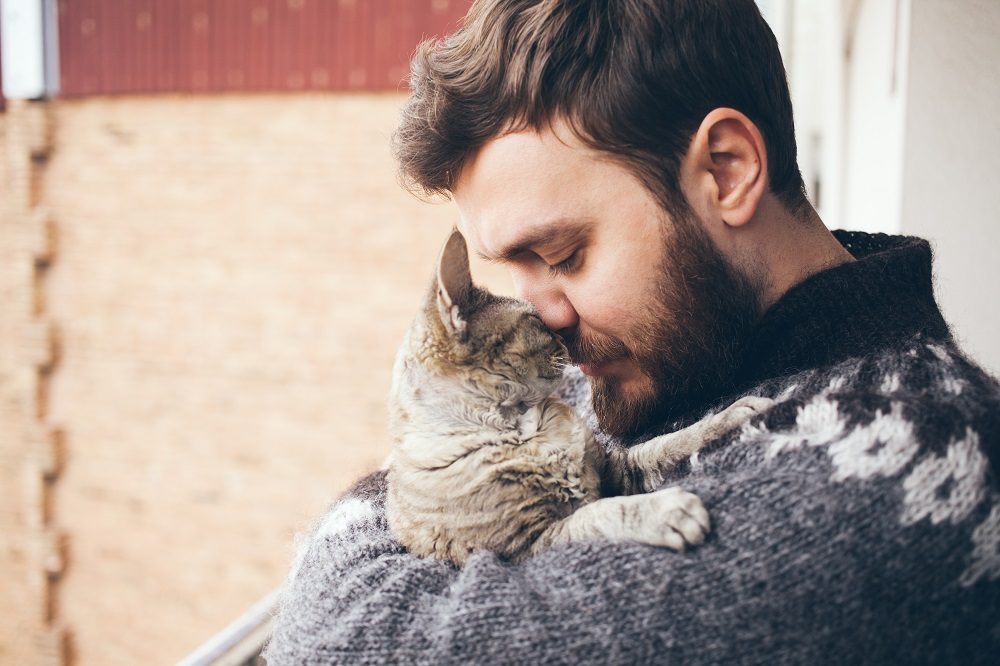
evrymmnt / Shutterstock.com
Companion animals provide their owners with a range of mental health benefits and can flood us with oxytocin (the love hormone). Pets are a constant comfort, an antidote to loneliness, and a tonic for stress.
My cats certainly provide me with steadfast companionship and love, which are hugely positive for my mental well-being. My affectionate boy, Jazzy, is always ready with a lap snuggle just when I most need one. But it’s hard to tell if that’s just a coincidence or if he can really read my mood.
Cats are often credited with a “sixth sense”—an uncanny ability to tell when things aren’t quite right. But do cats really know when we’re feeling low or are we applying human values to our feline friends? Let’s look at what the science tells us.
Can Cats Sense Your Mood?

Cats make us feel better, but it’s hard to know if they know when we’re down. Veera / Shutterstock.com
Domestic cats have been living alongside humans for thousands of years, and research has shown that cats bond closely with people. These social bonds can affect behavior and mood, with both parties benefiting from unconditional love and companionship. Cats are highly attuned to their owners, They can follow human signals, such as pointing and gazing, and can tell their owners apart from other humans with sight and voice cues.[1]
However, we know less about emotional recognition by cats. It’s an important skill for social animals to recognize emotions and moods in others. Human and cat companionship has been common in society for a long time, and this coexistence has made it possible—and even advantageous—for cats to read human emotional signals.
This talent has been shown by cats in various recent studies. A study in 2020 by researchers at the University of Bari examined whether cats recognize human emotions, by using both visual and auditory signals. Different emotional stimuli, such as “happiness” and “anger,” were portrayed by both facial expression and nonverbal sounds. The cats were able to discriminate between them, implying the cats can recognize these as separate emotional states.[2]
However, cats don’t rely on just our faces and vocalizations to read our mood. Cats are sensitive to changes in physiological parameters, such as heart rate, breathing cues and blood pressure, which can all be symptoms of depression, stress, and anxiety. They also are highly attuned to our schedules, with even small alterations to our daily routine will be noted by these clever furry friends.
Dr. Liz Baknall, a veterinarian and behaviorist in Bristol, U.K., agrees. “Cats are highly attuned to subtle cues that tell them when all is not well,” she said. “They can read our emotional state by observing our routines and habits, as well as facial and scent markers.”
It’s difficult to know just how closely cats are attuned to our emotions. Most studies have been based around “happy” and “sad” or “angry,” rather than anything more precise. It is thought that cats sense human emotions to a lesser degree than dogs, which is perhaps why they are less commonly seen as therapy animals. However, any cat lover will tell you that cats do seem to have a special awareness of their owners’ emotions and moods—mine certainly do![3]
How Cats Respond to Stress

Cats might act differently around you when they sense a change in your mood. Alina Troeva / Shutterstock.com
It has been found that cats might base certain behaviors and reactions on their owners’ cues, in a form of social referencing. For example, cats spend more time with owners when shown positive cues but look for an exit when owners respond in a fearful way to a new object.
If you’re feeling low or anxious, your cat will sense that your mood has changed and might alter their behavior accordingly. The way in which they respond does vary. Some cats will pick up on your stress and become anxious themselves, especially if their routine changes or the person interacts with them differently. This can manifest as inappropriate toileting, hiding away, changes to appetite, overgrooming, or other signs of feline stress.
Some cats may comfort their owner by showing more affection or just being present with them, providing love and company. They might rub themselves against you, spreading comforting pheromones to try to reduce anxiety. This may appear as the cat being more clingy or needy or just getting in your way more than usual!
It is well known that pet ownership has many health benefits, both physical and mental. Cats that help owners through tough times might be able to be registered as official helpers. Cats can’t be classified as service animals in the United States but can be emotional support animals (ESAs).[4]
It seems that cats can recognize certain emotions in people and respond to these changes in mood. It’s difficult to tell just how specifically cats can understand a range of human emotions, but they certainly might be able to tell when something is wrong. Cats have their own moods and personalities and might respond differently to anxiety or depression in their owners, but pets can be a huge source of comfort and support to many.
-
Edwards, C., Heiblum, M., Tejeda, A., & Galindo, F. (2007). Experimental evaluation of attachment behaviors in owned cats. Journal of Veterinary Behavior, 2(4), 119–125.
-
Quaranta, A., D’Ingeo, S., Amoruso, R., & Siniscalchi, M. (2020). Emotion recognition in cats. Animals, 10(7), 1107.
-
Galvan, M., & Vonk, J. (2015). Man’s other best friend: domestic cats (F. silvestris catus) and their discrimination of human emotion cues. Animal Cognition, 19(1), 193–205.
-
Beetz, A., Uvnäs‐Moberg, K., Julius, H., & Kotrschal, K. (2012). Psychosocial and Psychophysiological effects of Human-Animal Interactions: The possible role of Oxytocin. Frontiers in Psychology, 3.







